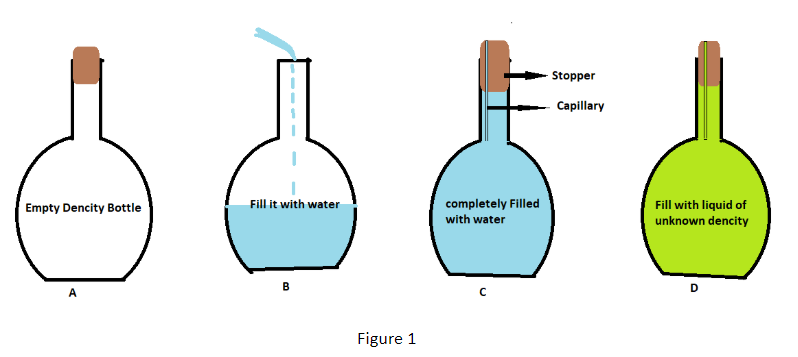
What is a density bottle?
Answer
579.3k+ views
Hint: In this question, we define the density bottle as it is a bottle of known volume that is first weighed empty and then weighed holding the liquid whose density is to be measured. After that using the using the expression ${\text{Relative Density}} = \dfrac{{{\text{Mass of liquid}}}}{{{\text{Mass of equal volume of reference liquid}}}}$ we can easily find the density.
Complete step by step answer:
Density bottle which is also known as a Pycnometer, specific gravity bottle, or pycnometer is a measuring device used to calculate the density of the desired liquids. A Density bottle is commonly made with glass. It is tightly fitted with a glass stopper and a capillary tubing is passed through the stopper to allow the air bubbles from the apparatus to escape easily. Using this simple apparatus we can accurately measure the density of any desired liquid with the help of a reference fluid, such as mercury or water by the use of an analytical balance as shown in figure 1.

At first, we take a density bottle of known volume and weigh the bottle when it is empty as shown in figure A then, we weigh it again after it is filled with water as shown with the figure C, and at last, we weigh it when it is completely filled with the liquid whose relative density is to be measure as shown in the figure D. After this, the relative density of the desired liquid can be estimated accurately. In other words, a specific gravity bottle is a bottle of known volume that is first weighed empty and then weighed holding the liquid whose density is to be measured.
Then using the following expression we can easily find the density.
$density = \dfrac{{Mass}}{{volume}}$
${\text{Relative Density}} = \dfrac{{{\text{Mass of liquid}}}}{{{\text{Mass of equal volume of reference liquid}}}}$
The densities of powder that are hard to measure using normal weighing methods can also be measured with a density bottle.
Note:
For these types of questions we need to have a good concept of density and relative density. We need to know what their expression is and to measure it. We also need to know about devices used to measure relative density such as Hydrometer, specific gravity bottle, Digital density meters, and Hydrostatic weighing.
Complete step by step answer:
Density bottle which is also known as a Pycnometer, specific gravity bottle, or pycnometer is a measuring device used to calculate the density of the desired liquids. A Density bottle is commonly made with glass. It is tightly fitted with a glass stopper and a capillary tubing is passed through the stopper to allow the air bubbles from the apparatus to escape easily. Using this simple apparatus we can accurately measure the density of any desired liquid with the help of a reference fluid, such as mercury or water by the use of an analytical balance as shown in figure 1.

At first, we take a density bottle of known volume and weigh the bottle when it is empty as shown in figure A then, we weigh it again after it is filled with water as shown with the figure C, and at last, we weigh it when it is completely filled with the liquid whose relative density is to be measure as shown in the figure D. After this, the relative density of the desired liquid can be estimated accurately. In other words, a specific gravity bottle is a bottle of known volume that is first weighed empty and then weighed holding the liquid whose density is to be measured.
Then using the following expression we can easily find the density.
$density = \dfrac{{Mass}}{{volume}}$
${\text{Relative Density}} = \dfrac{{{\text{Mass of liquid}}}}{{{\text{Mass of equal volume of reference liquid}}}}$
The densities of powder that are hard to measure using normal weighing methods can also be measured with a density bottle.
Note:
For these types of questions we need to have a good concept of density and relative density. We need to know what their expression is and to measure it. We also need to know about devices used to measure relative density such as Hydrometer, specific gravity bottle, Digital density meters, and Hydrostatic weighing.
Recently Updated Pages
Master Class 11 Economics: Engaging Questions & Answers for Success

Master Class 11 English: Engaging Questions & Answers for Success

Master Class 11 Social Science: Engaging Questions & Answers for Success

Master Class 11 Biology: Engaging Questions & Answers for Success

Class 11 Question and Answer - Your Ultimate Solutions Guide

Master Class 11 Business Studies: Engaging Questions & Answers for Success

Trending doubts
10 examples of friction in our daily life

One Metric ton is equal to kg A 10000 B 1000 C 100 class 11 physics CBSE

Difference Between Prokaryotic Cells and Eukaryotic Cells

1 Quintal is equal to a 110 kg b 10 kg c 100kg d 1000 class 11 physics CBSE

State the laws of reflection of light

Explain zero factorial class 11 maths CBSE




